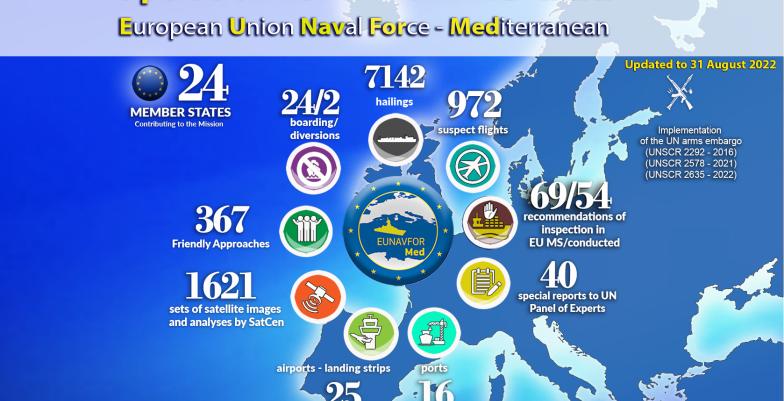What we do: Policies and actions
Maritime Security
Oceans and seas are vital to the EU’s security and prosperity. Over 80% of global trade goes through maritime routes and up to 99% of the global data flow is transmitted through undersea cables. The EU’s Member States form together the largest combined exclusive economic zone (EEZ) in the world and maritime regions account for 50% of the EU’s population and GDP. While maritime security is of critical importance, it is increasingly affected by a variety of challenges deriving from illicit activities, geopolitical rivalries, competition for natural resources, and other dangers such as cyberattacks and hybrid threats. It is essential for the EU and its Member States to reaffirm their commitment to the rules-based order at sea and to consolidate the EU’s role as a global maritime security actor.
Navigate the topic
Ensuring free, safe and open seas
The EU is one of the leading contributors to maritime security through operational engagements and naval presence, investment in capacity-building and support to regional maritime security architectures in the Gulf of Guinea and in the Indian Ocean, and cooperation with a variety of partners, including the UN, NATO, regional organizations as well as a growing number of third countries.
On October 2023, the EU adopted a revised Maritime Security Strategy (EUMSS) and its associated Action Plan. In line with the Strategic Compass for Security and Defence of 2022, this strategy intends to strengthen the EU’s autonomy and capacity to respond to threats in the maritime domain, safeguard its interests at sea, and protect its citizens, values and economy. It updates and builds on the first EU Maritime Security Strategy dating from 2014, continuing to address security challenges at sea in a comprehensive manner. As in 2014, the updated strategy sets a general approach with guiding principles to ensure coordination and consistency between the EU's various instruments and policies contributing to maritime security.
The new and updated strategy also reflects the significant progress made since 2014 in responding to maritime security challenges in European sea basins and beyond. It has enhanced coordination between EU and Member-States civilian and military authorities, in particular for the exchange of maritime information. It has enhanced the EU’s credibility as an international maritime security actor and relations with external partners in this field. The drastic changes in our strategic environment as well as the climate crisis and environmental degradation have made the seas a more and more contested domain. The EU has been actively promoting and advocating multilateralism and the rules-based order at sea.
The revised strategy focuses on six strategic objectives:
- Step up activities at sea: organize annual naval exercises at EU level to boost readiness and foster interoperability; deepen cooperation between coastguards at EU level; develop further the Coordinated Maritime Presences, a tool to enhance coordination of Member States naval and air assets in maritime areas of interest for the EU.
- Cooperate with partners: deepen cooperation with NATO; step up cooperation with other relevant international partners, in particular in Asia, Africa and the Pacific, to uphold the rules-based order with the UN Convention on the Law of the Sea at its core.
- Lead on maritime domain awareness: reinforce maritime surveillance; enhance maritime domain awareness at the EU level through the Common Information Sharing Environment (CISE), which will enable Member-States and EU authorities to share maritime information through dedicated and secure channels.
- Manage risks and threats: conduct regular live exercises involving civilian and military actors in order to improve response capabilities to traditional, new and evolving risks and threats; monitor and protect critical maritime infrastructure such as ports, offshore renewable energy installations, offshore oil and gas oil platforms as well as undersea cables and pipelines.
- Strengthen capabilities: develop common requirements for defence technologies in the maritime domain; step up the work on collaborative projects such as the European Patrol Corvette (new class of warship); improve our anti-submarine capabilities.
- Educate and train: develop qualifications, notably on cyber and hybrid threats, and conduct training programmes open to external partners.
The Maritime Security Strategy will contribute to a more coherent engagement of the EU in external conflicts and crises to enhance the security of the EU and its citizens. In accordance with the EU Integrated Approach, it will leverage all relevant EU civilian and military policies, tools and instruments to strengthen coordination and synergies among all relevant actors at European, regional and national level.
Coordinated Maritime Presences
A tool to enhance coordination of naval and air assets
The EU conducts naval operations under its Common Security and Defence Policy. In addition, the EU implements Coordinated Maritime Presences (CMP).
Documents
- A Global Strategy for the European Union's Foreign and Security Policy
- Revised Maritime Security Strategy (EUMSS) and its associated Action Plan
- Council Conclusions on Maritime Security (22 June 2021)
- Council Conclusions on Security and Defence (10 May 2021)
- Council Conclusions on an EU Strategy for cooperation in the Indo-Pacific (16 April 2021)








